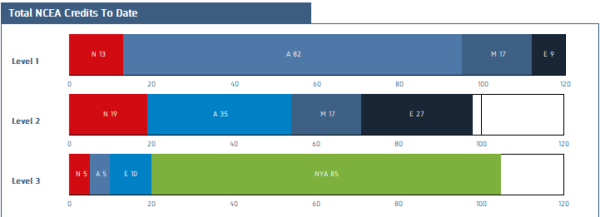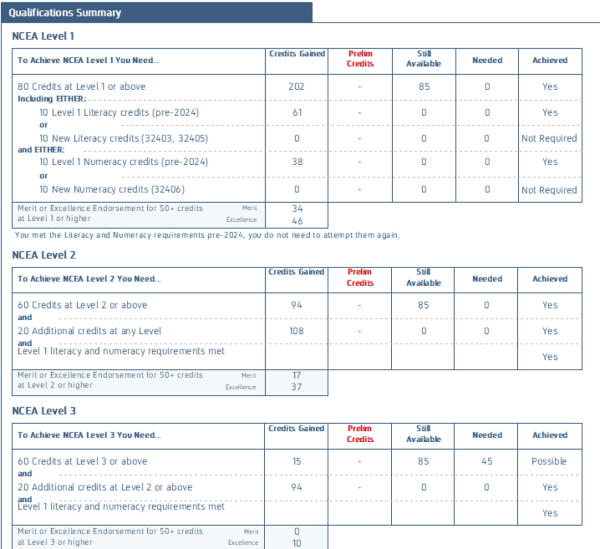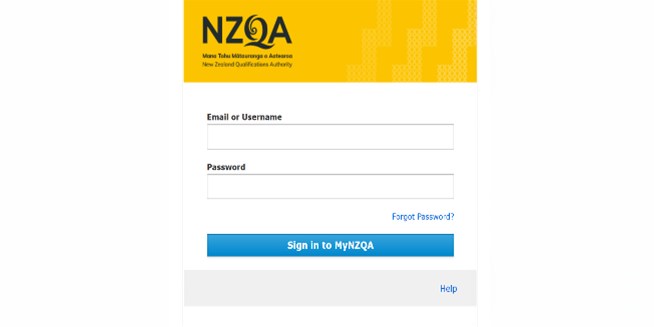
You are logged in as
Logout
You are logged in as
Logout
Dear Parents and Caregivers
We’re at the end of a hugely busy term – but what lies ahead is likely to be even ‘huger’! As we head towards Term 3, the ‘moving term’, there are a few issues that I would like to cover. We’re already into Week 18 of the academic year, with (amazingly so!) just 14 weeks left, so this newsletter encourages busy parents to take a few minutes to check in on your child’s progress in their NCEA journey and to look ahead at what is to come in Term 3. How is it looking for your child?
At all times, please feel free to contact me via email with any questions that you may have about NCEA, or matters raised in this newsletter at DBV@stac.school.nz.
Kind regards
David Bevin
Head of Teaching and Learning – Secondary

In May, Year 11 students sat at least one assessment, probably the final one of three such assessments, for the co-requisite. The 20-credit co-requisite is required for a student to gain any NCEA level award and, while we have yet to see any results, many Year 11 students will successfully gain this requirement this year.
All Year 11 students sat the Literacy – Writing assessment and a number also sat one or both of the Literacy – Reading and Numeracy assessments. Results are awaited with great interest and students don’t have too long to wait; the Reading results will be available on or about Wednesday 25 June (the last week of term) and the Numeracy and Writing results will be available on Monday 14 July, the first day of Term 3. NZQA reported this week that “Across the Literacy, Te Reo Matatini - Te Reo Torohū, Numeracy and Te Pāngarau standards, 175,000 assessments were completed. We are currently marking and processing those results. Over 98% of assessments were completed digitally.”
Following is a bit more information from NZQA published on their website in recent weeks – a sign of things to come perhaps?
Automated Text Scoring
Starting at the May 2025 assessment event, Automated Text Scoring will be used on all digitally submitted Writing assessments.The Automated Text Scoring is a stand-alone technology tool that has been trained specifically on past co-requisite Writing assessments that were marked by humans in order to learn what makes a piece of writing meet the requirements of the standard.
NZQA conducted a small-scale trial of Automated Text Scoring on Writing assessment responses from the May 2024 assessment event, and a large-scale trial using 35,000 Writing assessment responses from September 2024. These trials allowed us to compare the results with scores provided by our regular markers.
While the trials have provided us with confidence in the accuracy of Automated Text Scoring, to continue to quality assure for consistency and accuracy we are also using a human check-marking process. Human marking will be done where the student is on the boundary of achieving/ not achieving the Writing standard, which will amount to approximately 40% of assessments.
Using Automated Text Scoring is a crucial component of reducing the time it takes to mark Writing assessments, reducing the workload on markers who are practising teachers, and enabling marking to be conducted outside of school holidays.
You will remember this very simple model of your child’s Level 1 journey.
(note the links to information that can be accessed directly from here)
| Term | Length (weeks) | What's Happening | Be Aware Of | Check For |
| 1 | 10 |
Summer tournament week – Week 9 Parent-Teacher interviews – Weeks 9–10 |
set up for learning understanding NCEA amount of internal assessment likely manageable watch time management and develop good study habits device readiness for completing assessments and examinations |
Course Outlines (incl. assessment progress) on intranet Term Assessment Calendar for dates on intranet Talk/s from Mr Bevin and NCEA newsletters (x 2) on NCEA tab |
| 2 | 9 |
A ‘clear’ term for lots of assessments Week 4 Common Assessment Activities (LitNum) Mid-year reports Week 5 |
sports and cultural events happening increasing internal assessment and possibly challenging time management skills high-stakes NCEA assessment event |
Term Assessment Calendar for dates incl CAAs on NCEA tab Talk/s from Mr Bevin and NCEA newsletters (x 2) Teachers’ feedback in reporting |
| 3 | 10 |
More internal assessment Internal assessment ends mid- September Winter tournament Week 7 Prelim examinations Weeks 8–9 (preparation for NCEA) and Common Assessment Activities (LitNum) |
internal programmes finish last week of term assessment pressure building challenging time management skills and prioritisation impact on momentum of work of Winter tournament week? pressure of Prelim examinations (for derived grades) |
Term Assessment Calendar for dates incl CAAs (during Prelims) on NCEA tab Prelim examinations timetable (late August) on NCEA tab Post-Prelims academic conference (end of term) |
| 4 | 3 (+1 day) |
External submissions uploaded or sent away (e.g. DVC, Art) School ends Monday 3 November Level 1 NCEA examinations start 10 November. (Year 11) – 2 ½ weeks long |
completion of programmes pressure of revising for, and sitting, NCEA examinations final day Monday 3 November |
NCEA examinations study leave NCEA examinations timetable (10 – 26 November for Level 1) |
So, the situation for each student is, as showing in the model, quite a lot more internal assessment has been completed, credits gained and increasing and a likely very busy term to come following the 2-week holiday. You’ll see that there’s still more assessment to take place (you’ll possibly wonder what ‘lots of internal external assessment’ means in practice), there will quite possibly be events and commitments alongside your child’s academic life and of course there are the College Prelim examinations. What the model doesn’t show is the 2025 course selection process that happens in August too. There’s a bit more to come on that at the end of this newsletter.
This very important calendar provides overview information about what assessments are on when, according to each Year level. Please note that assessment programmes are of necessity a little ‘fluid’ and therefore dates sometimes change; teachers are expected to keep students and parents informed of such changes so please understand that what is on the Calendar, while it’s accurate, is not ‘set in stone’. The Calendar, available on the intranet by clicking here provides an important way of helping your student to programme their commitments term-by-term.
Looking out for Term 3 Assessment – there’s a lot coming up, including externals being worked on. You’ll see that the next term is 10-weeks long and that there’s likely to be a lot going on in your child’s academic life for one thing! There’ll be more on that in my next newsletter early next term.
Right now, the Assessment Calendar shows assessment dates for internals in each subject (you can see the screen shot showing assessments taking place in July) and it will be a good exercise to sit with your child and check out what they have coming up. The College Prelim examinations, timed for the period Wednesday 3 – Friday 12 September (details to be confirmed), are very important events in a range of ways and do need to be prepared for and taken seriously. I have previously informed parents about the requirement for students to be present at each of their examinations and this will be reiterated in subsequent newsletters in Term 3.

It’s very relevant at this point to remind you of the ‘one-stop shop’ nature of our Community Portal that is accessed through the college intranet. When clicking on the ‘Reports and Documents’ tile in the Portal, parents are able to access a lot of information provided by the College with regard to attendance, assessment and reporting.
When you click on the Results tab, as you know already, you will be able to access both the Fortnightly Feedback and the ‘powerful’ and dynamic NCEA Current Results Summary. This document enables you to see the grades that your child gains over the course of the year in their various internal assessments and practice/indicative assessments and their progress towards Level 1 NCEA awards such as certificate and course/subject endorsement and towards gaining the Literacy/Numeracy co-requisite (as you can see here).

You will be able to see the subject, standards, credit values and, when results are recorded by teachers, grades gained for those standards.
The summary bar graphs of NCEA credits to date give a snapshot of the split of Not Achieved/ Achieved/ Merit/ Excellence credits.

The ‘Qualifications Summary’ tables provide an excellent summary as you see here with this fictitious Year 13 student (hence nearly three years of results being summarised):

As the year progresses and internals are completed, it will become very interesting reading that you will not need to ask your teenager to show you – there’ll be no ‘hiding’ from results!
Students are able to access the same records as you through their own access to the Community Portal. They are therefore able to see their results as they are updated on the Current Results Summary.
In addition to that document, as parents know, all students have their NZQA Learner Login which is the definitive location for all confirmed results (and the login details for which are used for students to login to their online assessments and exams). This is where students will access their final 2025 NCEA results in mid-January 2026, and it is accessed through a username and password that are set by the student themselves. My advice to parents is to get the student to show you this so that you are able to see what things students can access in the Login, such as the way to order confirmed Results Notices and a formal copy of the NZQA Record of Achievement.


Looking ahead at the next year of study (image currently shows only 2025 courses material).
You might wonder why we require our students to select their courses for the next year so seemingly early on. We do this because it takes us a lot of time to put together our staffing and timetables for the following academic year. It’s not something that we can leave until Christmas time and is what all schools do. To assist students and their parents in this task, we undertake an ongoing comprehensive information plan and process that runs through the first half of next term. That plan and process generate a new ‘hive of activity’ in students’ minds and in their conversations, particularly as they move higher up through the year groups. I will provide more information to you about this early next term but do be aware that it’s coming. Students need to think about what they will study next year and will be required to make decisions about that, so it must be good decision-making!
As you already know, some NCEA external assessment (including the Literacy/Numeracy Co-Requisite assessments) is completed digitally, for example, most Year 11/Level 1 examinations are done online (22 out of 25 Level 1 end-of-year examinations are available digitally). This is part of a process whereby NZQA runs a dual digital and paper assessment system that has been running since 2016. For those of you who may be interested in reading about this, I have included a link that takes you to a digital assessment insights paper that explores uptake in schools and kura, the benefits to students and a study on the impact on student achievement outcomes in digital compared to paper assessments.
The paper can be accessed by clicking here. NZQA reports that “our surveys of students undertaking digital assessment show that they value the features of digital assessment. There is overwhelming student support for being able to ‘word process’ their exam responses.”

· NZQA for extensive information about NCEA qualifications and assessment, and much more – NZQA resources and videos :: NZQA
· NCEA Examination Timetable - National secondary examinations timetable » NZQA
· Submission Dates for externally-assessed portfolios and reports - National secondary examinations timetable » NZQA. These assessments are worked on and completed in school in a way similar to internal assessment, however, work is sent to NZQA markers for verification (sample checking) or full assessment.